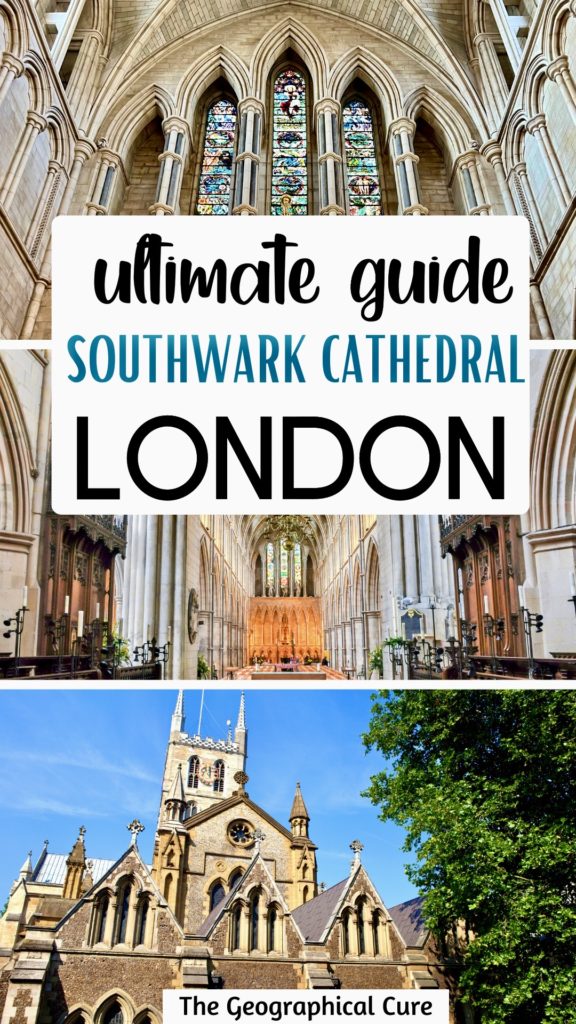Here’s my guide to visiting Southwark Cathedral in London. The church is a little Gothic gem that dates back to 606 A.D. and is London’s oldest Gothic structure.
Although it’s overshadowed by the glamorous St. Paul’s Cathedral, Southwark is an important London landmark that’s well worth visiting.
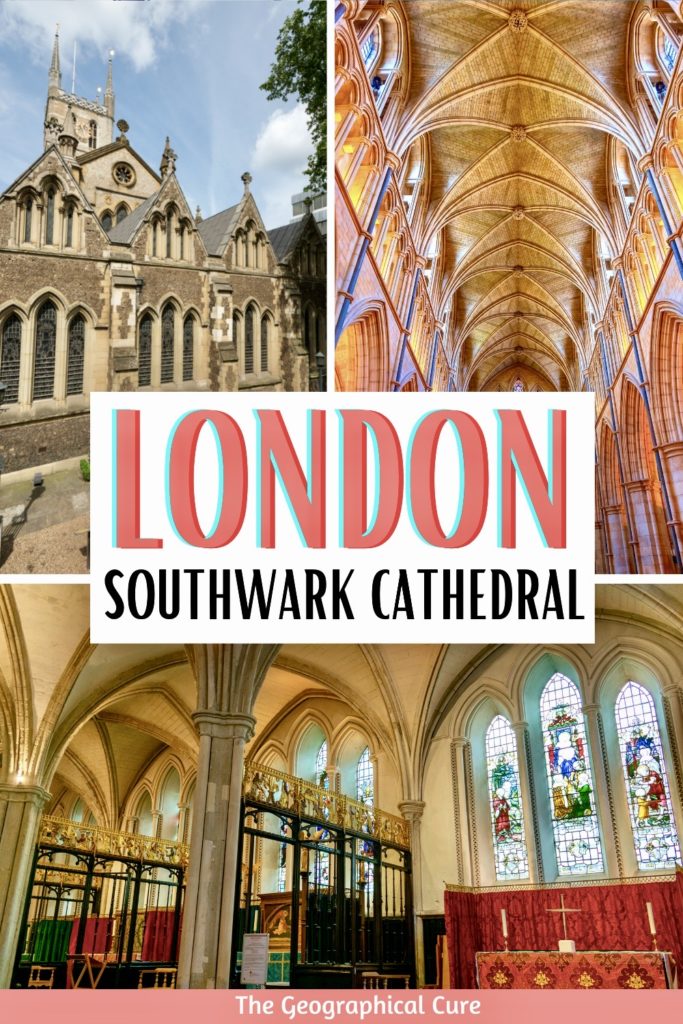
It’s been a place of Christian worship for over 1,000 years. The church is simply filled with history.
The church has welcomed an interesting cast of characters over the centuries, including William Shakespeare, Geoffrey Chaucer, Charles Dickens, and John Harvard.
It’s a living building, not a relic of the past. New things are constantly being added, making it a delightful fusion of old and new.
History of Southwark Cathedral
Before I dive into my guide to Southwark Cathedral, let’s take a brief look at the cathedral’s history. It stretches back to the days when Rome occupied London. William the Conqueror set the nascent structure to flame when he arrived in town in 1066.
By 1086, the cathedral had recovered enough to be mentioned as a monastery in the Domesday Book, a property survey that William commissioned. In 1106, an Augustine priority was established.
In 1212, fire severely damaged the site. The church was rebuilt, but then hit with a second fire in the 1390s.
In the 15th century, with the help of the Bishop of Winchester, Henry Beaufort, funds were raised to restore the church once again.
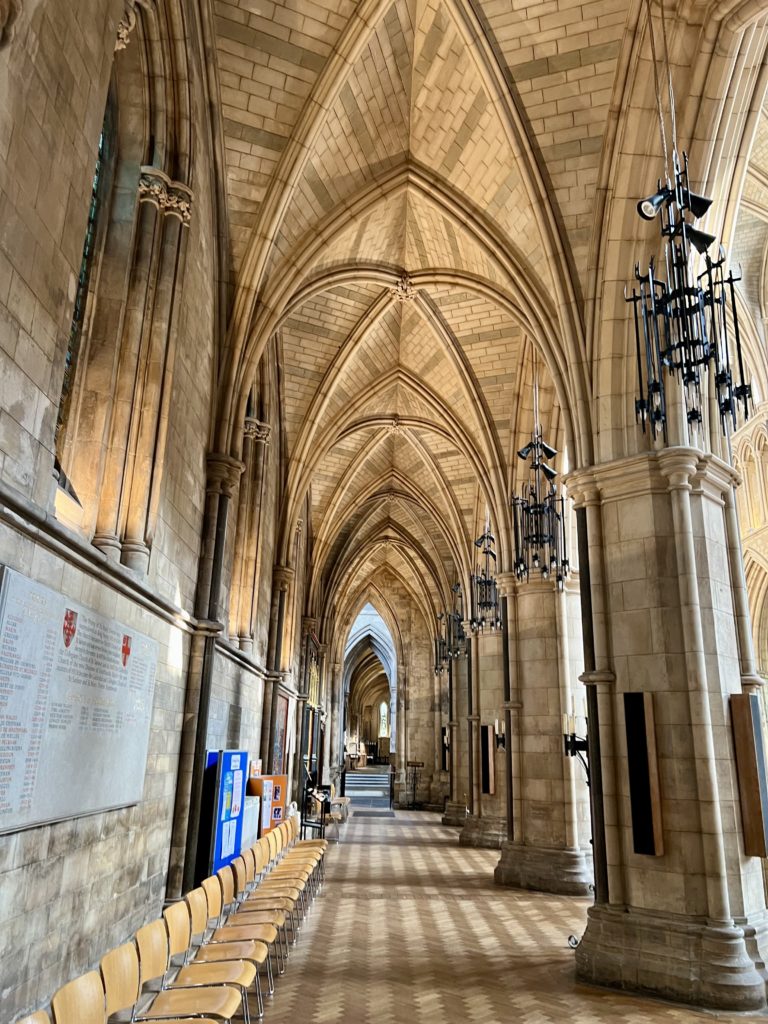
By this time, fashions had changed. The rounded Norman arches were replaced with pointy Gothic arches.
Shakespeare fans will want to know that Southwark gave a warm welcome to the burgeoning theater industry. In fact, the church is just steps from Shakespeare’s Globe Theater and the site of other former Bankside theaters.
The cathedral has royal connections too. King James I of Scotland married the niece of the Bishop of Winchester, Joan Beaufort, in the priory church in 1423.
In 1539, Henry VIII confiscated the church during the Reformation. But, as a sign of royal favor, he allowed it to continue as a parish church under the name of St. Savoir of Southwark. Though he also demanded annual “rent” for the privilege.
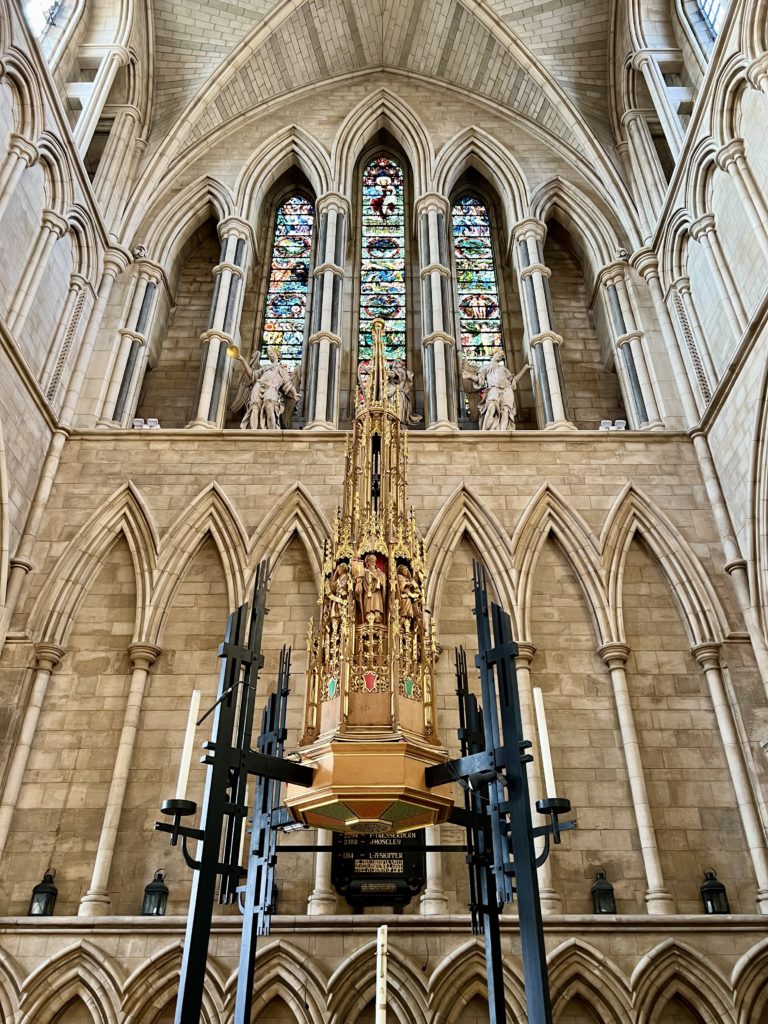
During the Tudor years, Mary I held heresy trials in the cathedral. In 1614, several members of the administering vestry purchased the church from James I.
In the 19th century, Southwark was once again in disrepair and some wanted to tear it down. But others, realizing its historical importance, mounted a fierce campaign for restoration.
In 1905, the restored Southwark got a bump up in status, becoming a cathedral. Today, it’s an active parish and working cathedral.
In the 1980s and 1990s, a new building was added to the north side, which is linked to the cathedral by an internal glass covered walkway.
It houses an education center and museum shop. There’s also an archaeological chamber.
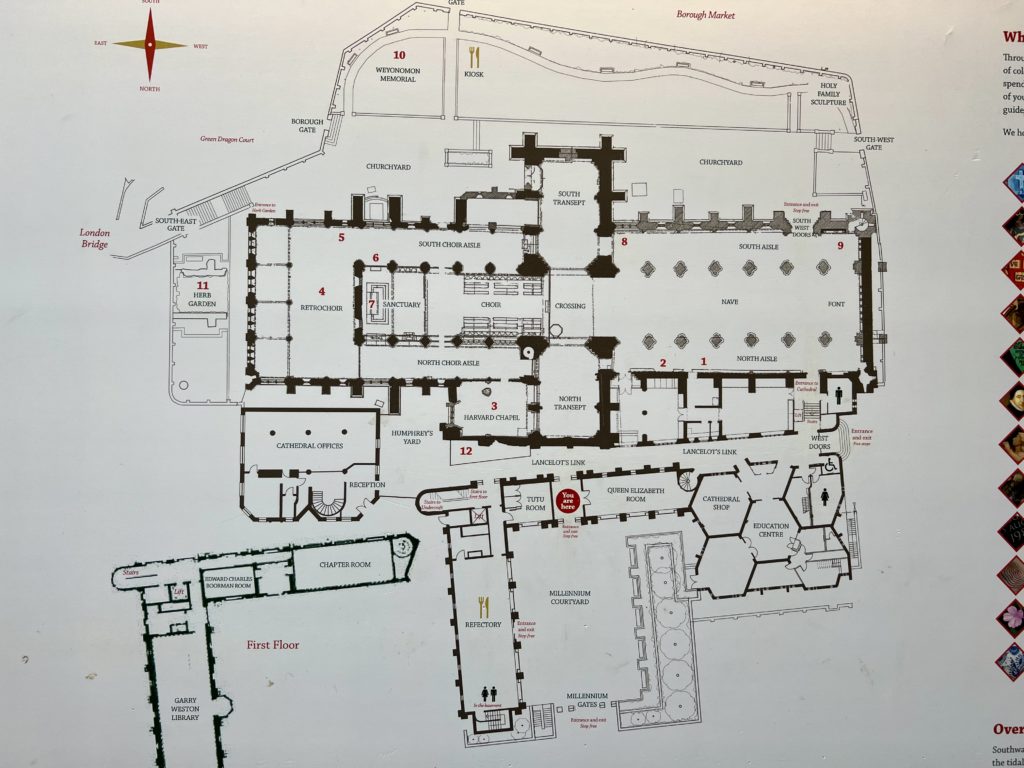
Guide To Southwark Cathedral: What To See
The cathedral has a rather calamitous and unsympathetic setting, hemmed in by busy roads on the touristy South Bank. Inside, however, it’s a haven of peace that transports you back in time.
The church contains many beautiful things. Here are some of the highlights to see on a visit.
Facade
The cathedral took its present form between 1120 and 1420. The older Norman influences can be seen in the rear facade. The Gothic influences are on the front.
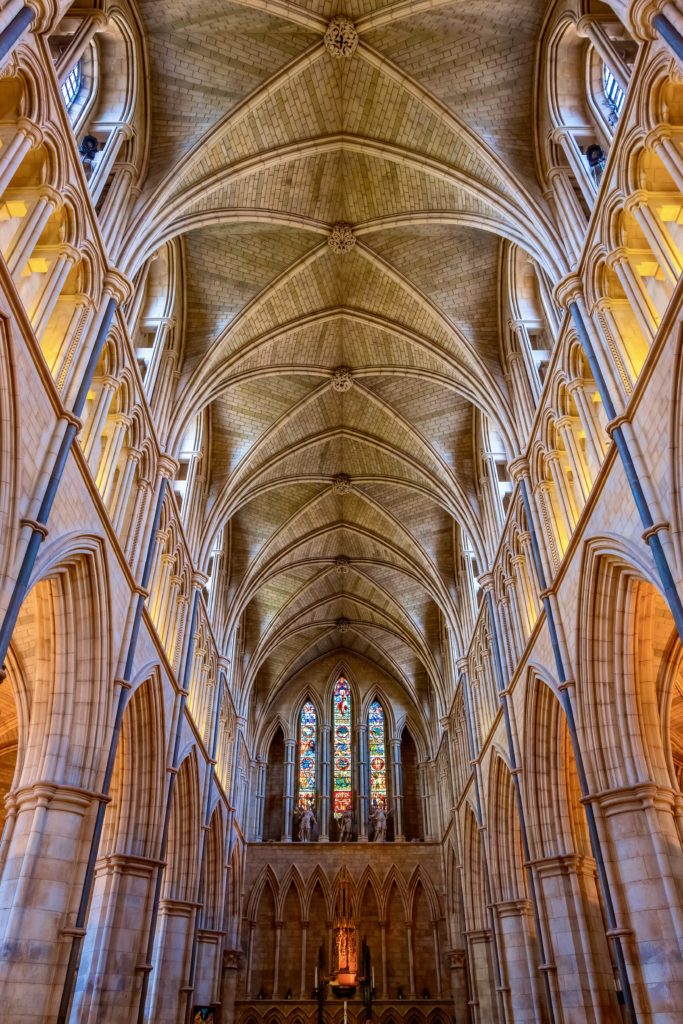
Nave
The airy vaulted nave was designed by Sir Arthur Blomfield and dates from 1897. It’s made of sandstone colored brick and is a near replica of the original 13th century nave. It’s also outfitted with state of the art lighting, which makes it a pleasure to visit.
This nave replaced an elaborate 15th century wooden nave that had decayed over time. While the new vaulting was being installed, the cathedral sat roofless for 50 years.
The stained glass windows on the south wall depict the Bishop of Canterbury blessing his cathedral. It’s from 1953, and replaced a windows that was destroyed by bombing in WWII.
The window on the north wall depicts St. Augustine holding an episcopal staff and a flaming heart.
You can see some remains of the medieval nave by the southwest doorway.
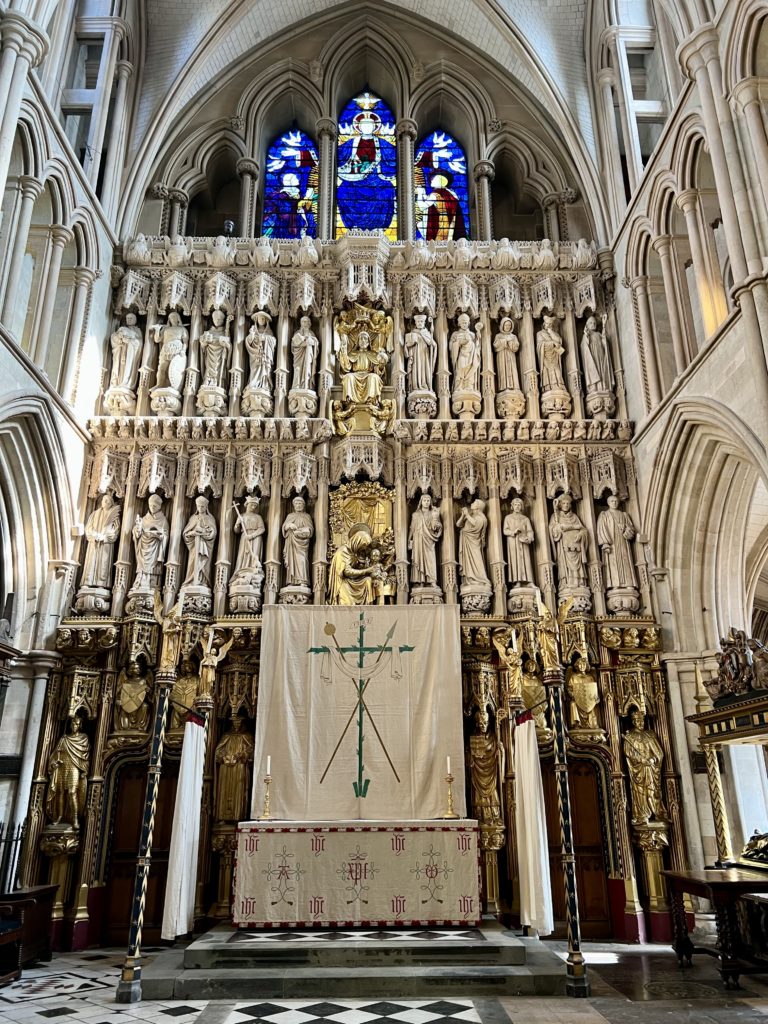
Altar Screen
Behind the high altar is a “Great Screen” that’s a cathedral treasure. It was erected by Bishop Fox of Winchester in 1520.
It’s uncertain whether the original statues in the two broad bands were ever installed. What you see today are Victorian replacements carved by Messrs Nicolls of Lambeth from 1905 onwards.
The figures tell the history of the church in which they stand.
You’ll see Cardinal Beaufort, the King of Norway, Henry I, Saint Peter, Saint Paul, Thomas Becket, the Bishop of Winchester, Aldgun (the first prior of the Norman church here), and John Gower (middle row, third from the right).
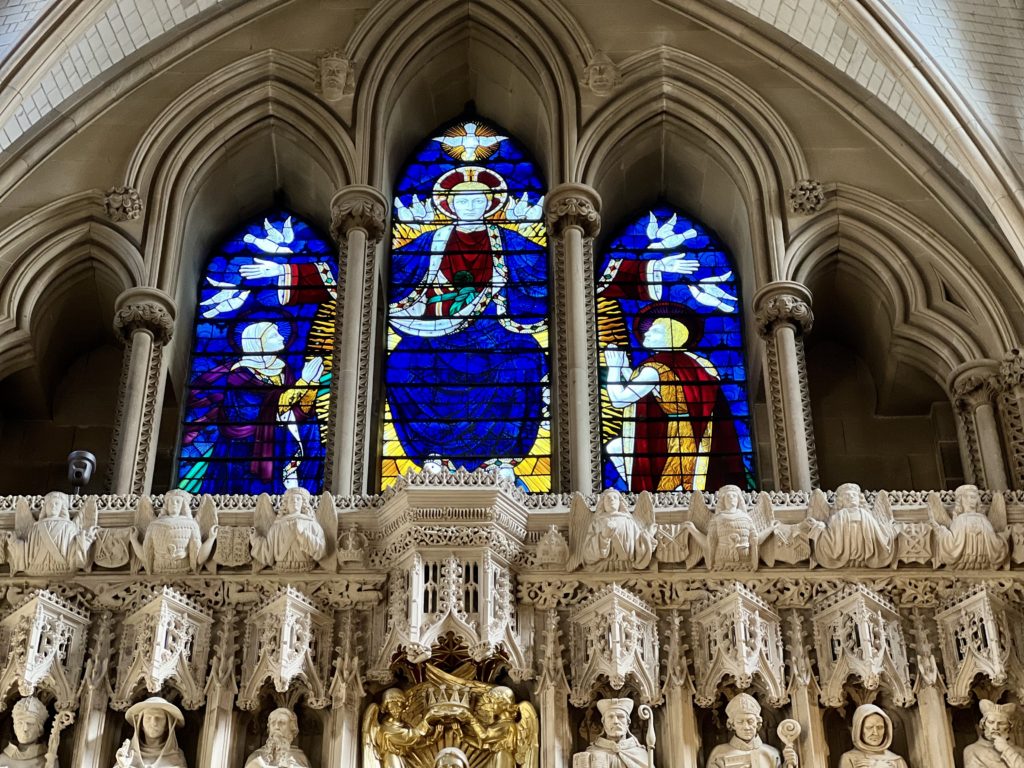
In 1930, the lower portion was gilded and a new panel showing the Greek and Latin Fathers of the Church was added. This was inspired by a panel in St. Mark’s Cathedral in Venice.
The stained glass window at the top of the screen dates from 1950. It depicts a youthful Christ clad in vibrant blue and sitting in majesty.
The Virgin Mary is on his left and St. John the Evangelist is on his right. Christ sits above a blue starred globe and is surrounded by seven doves, symbolizing the Holy Spirit.
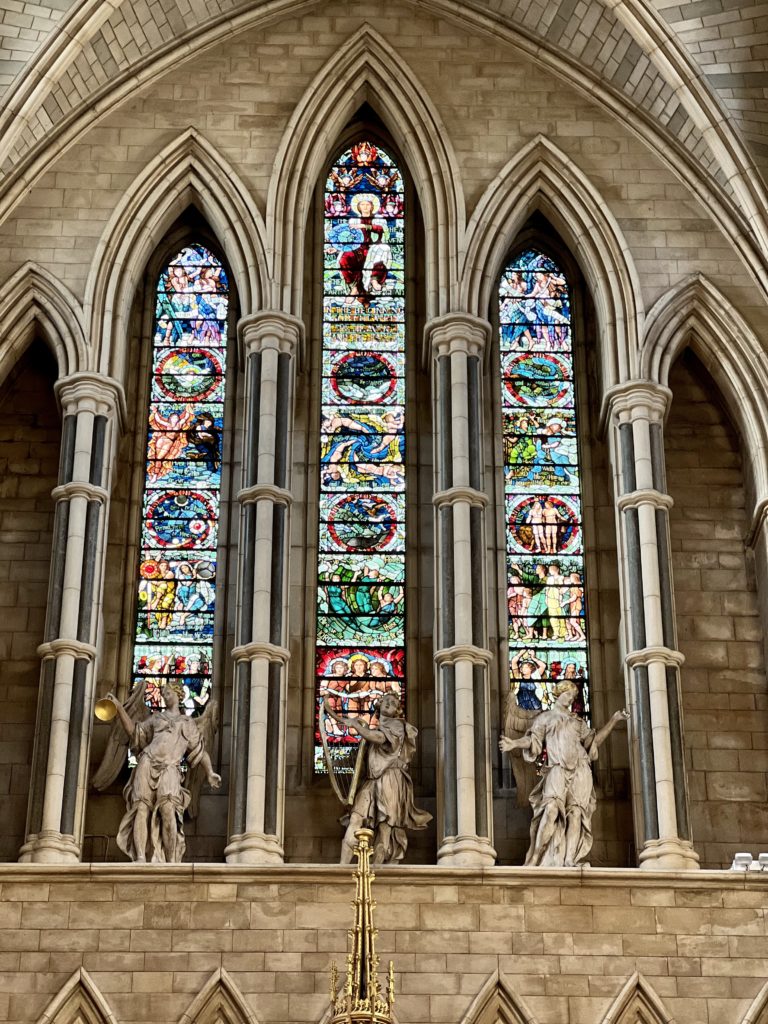
West Window
The west window dates from 1903 and was one of my favorites. It’s a superb creation by artist Henry Holiday. The style is Pre-Raphaelite and the theme is the creation of man.
Christ is enthroned as creator of the world. The six days of creation are depicted in the six circles. At the base of the window are the Holy Children in a burning furnace.
There are three lime wood figures on the windowsill. They represent King David and two angels. They were formerly part of the old nave.
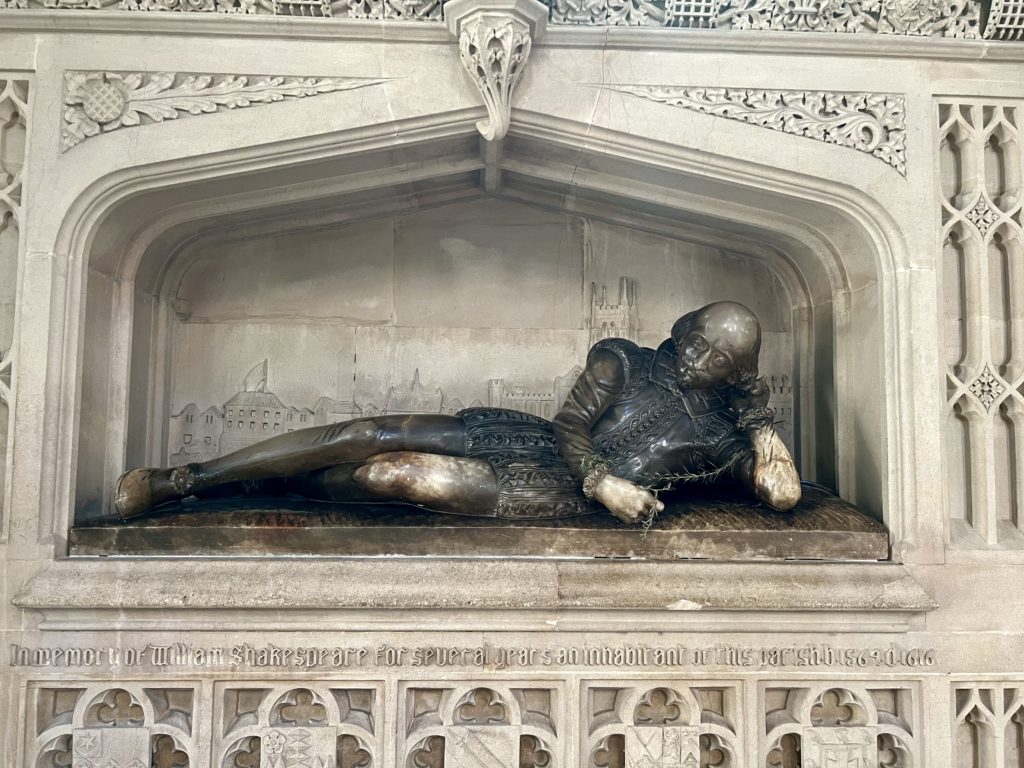
Monument to Shakespeare
No guide to Southwark Cathedral would be complete with telling your about the Shakespeare Monument. Shakespeare likely lived in the South Bank area and prayed at the cathedral while his brother rang the bells.
The rather sentimental tribute to Shakespeare is in the south side aisle. The shrine has a statue of the Bard at rest in a meadow, perhaps dreaming about his plays. Behind the statue is a frieze of what Southwark “probably” looked like back in his day.
The bright window above pays tribute to his comedies and tragedies. The central character is Prospero from The Tempest. Ariel is above him and Caliban is at his feet.
The left lancet (tall narrow window) depicts characters from Shakespeare’s comedies. The right lancet shows characters from his tragedies, including Hamlet addressing a skull.
You will sometimes find flowers or rosemary in Shakespeare’s hand.
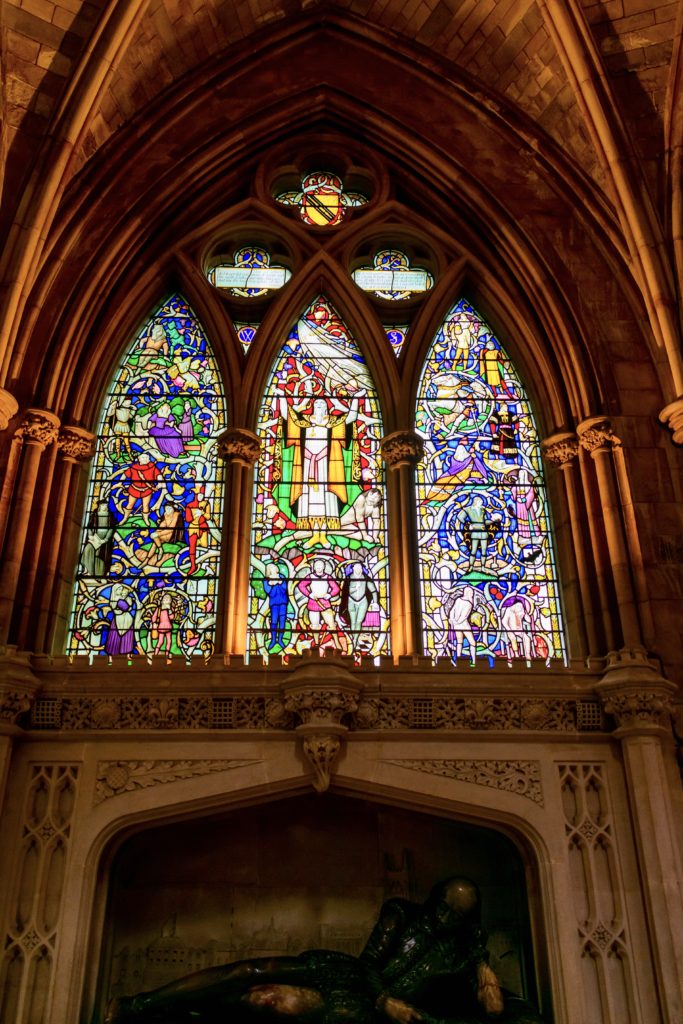
There is also a fairly recently added memorial in honor of Samuel Wanamaker, the man behind the reconstructed of Shakespeare’s Globe Theater in South Bank.
For yet another Shakespeare memorial, you can pop into the Harvard Chapel.
This one is a dedication to younger brother Edmund Shakespeare, who died of the plague in 1607. The Bard himself is buried in his home town, Stratford-upon-Avon.
READ: One Day In Stratford-upon-Avon, Shakespeare Day Trip From London
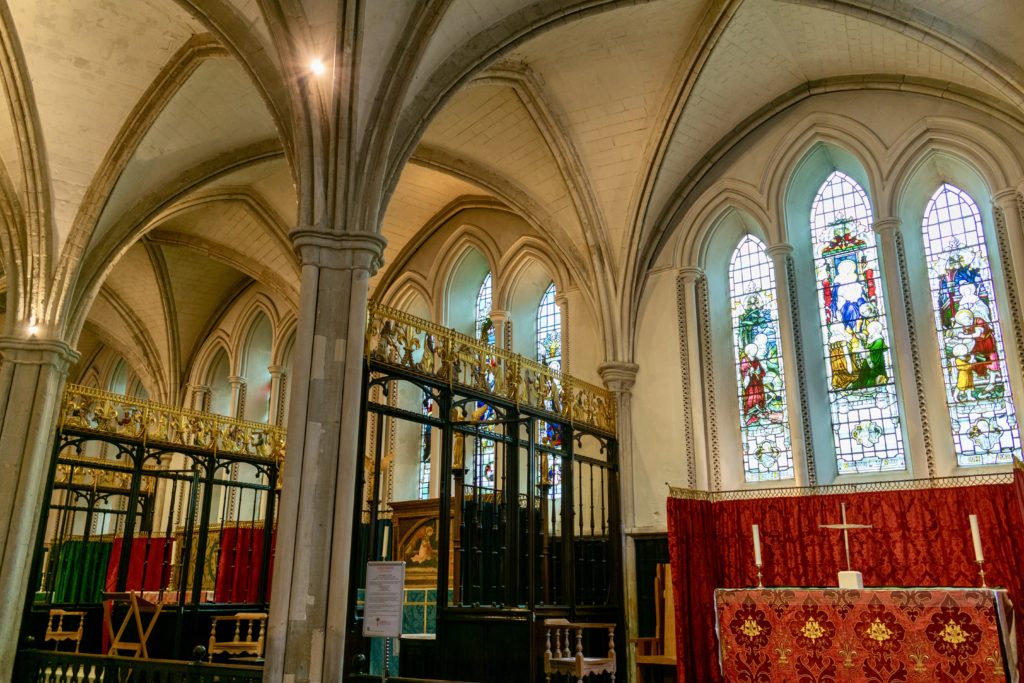
Retrochoir
Dating from 1215, the Retrochoir is the oldest part of Southwark and the earliest surviving example of Gothic architecture in all of London. When finished, the church was known as St. Mary Overie (over the river).
It was once used as a Bishop’s Court to conduct heresy trials during the reigns of Henry VIII and Queen Mary I. After that, of all things, it was used as a space to winter pigs and fowls.
There are four chapels dedicated to saints and a WWI memorial, which has a medallion depicting St. George and the Dragon.
You’ll also find some beautiful stained glass windows, including the Diamond Jubilee Window, which I discuss below.
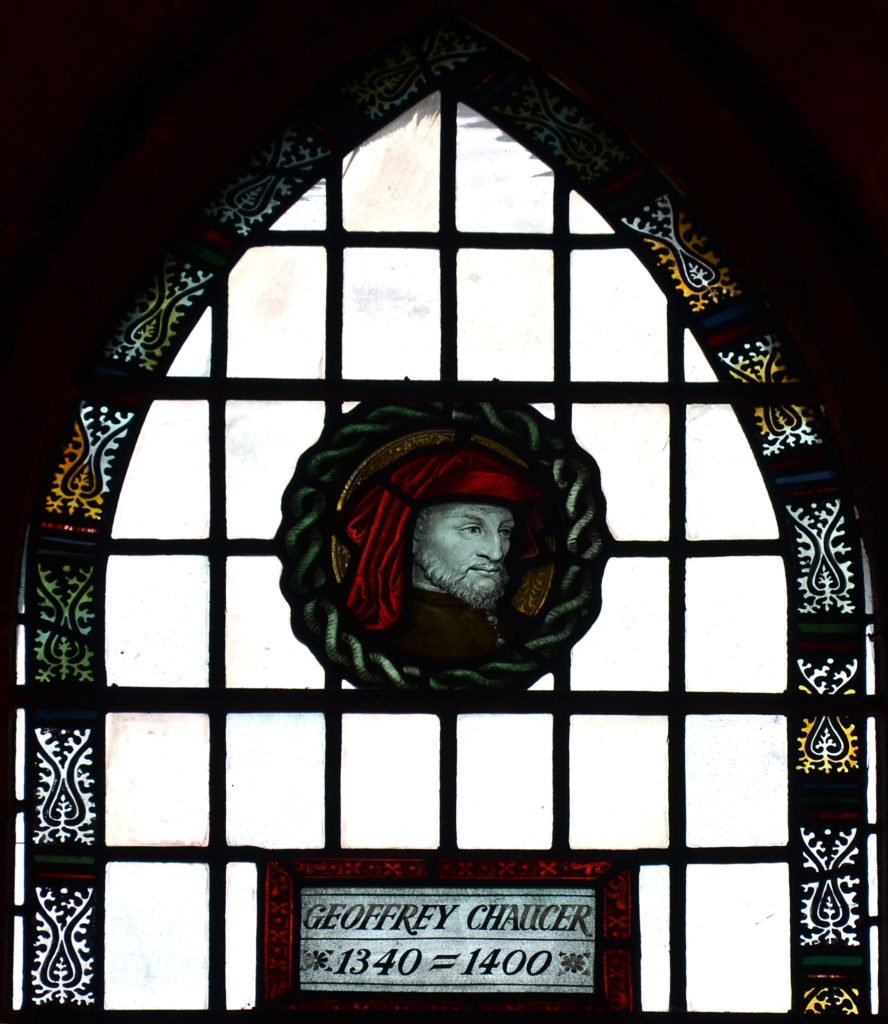
Chaucer Window
Designed by John Lisle, the Geoffrey Chaucer window is located at the east end of the north nave.
It has a familiar depiction of Chaucer in a roundel. Below him are the 14th century pilgrims from his famous novel The Canterbury Tales.
They riders set out on horseback from the Tabard Inn to visit the shrine of the murdered Archbishop of Canterbury in Canterbury Cathedral. Becket was murdered by Henry II, which was a defining moment in English history and made Becket an instant martyr.
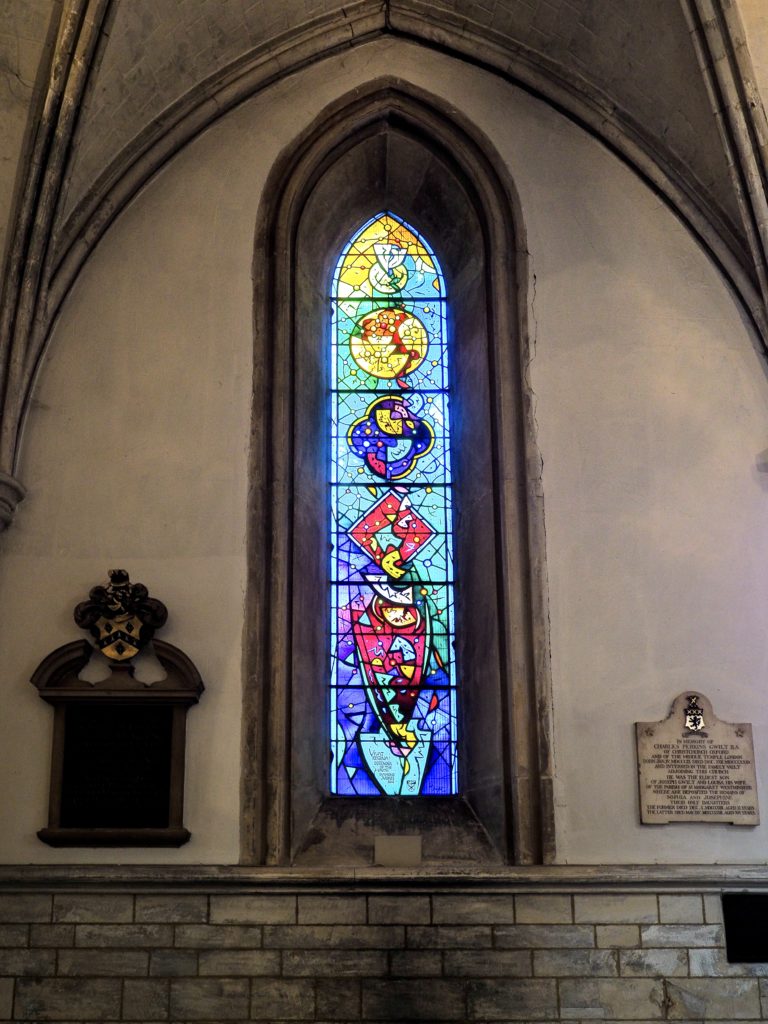
Diamond Jubilee Window
The Diamond Jubilee Window is a four lancet window tucked into a side of the retrochoir. It’s a tribute to Queen Elizabeth II reign of 60 years. It’s said to depict “jewels descending from heaven.”
The window is quite different from the other stained glass windows in the cathedral, much more modern. It’s vibrant and stunning in person.
Icelandic artist Leifur Breidfjord won a competition to design the window. It’s inscribed “Vivat Regina! | Defender of the Faith | Diamond Jubilee 2012.”
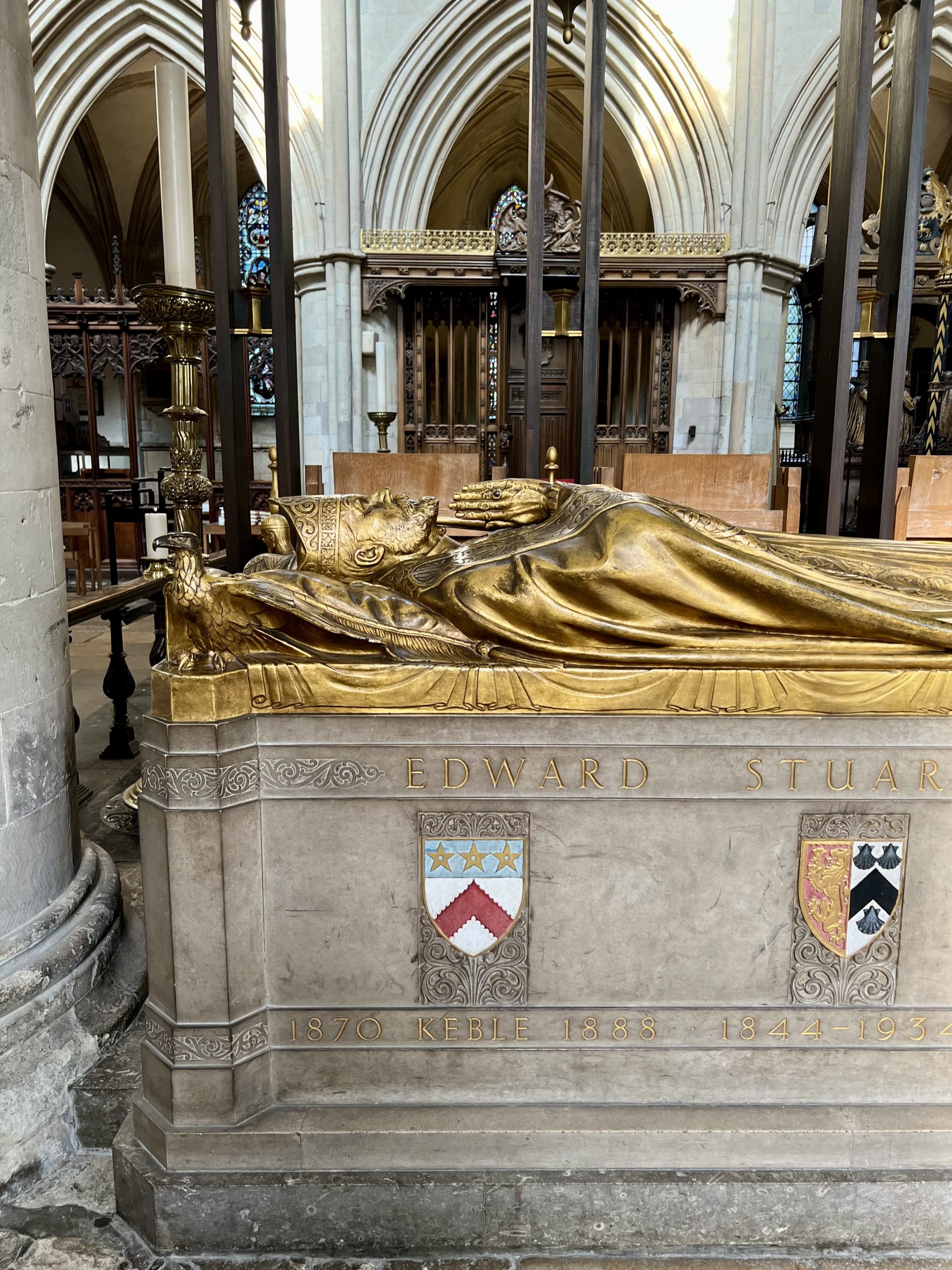
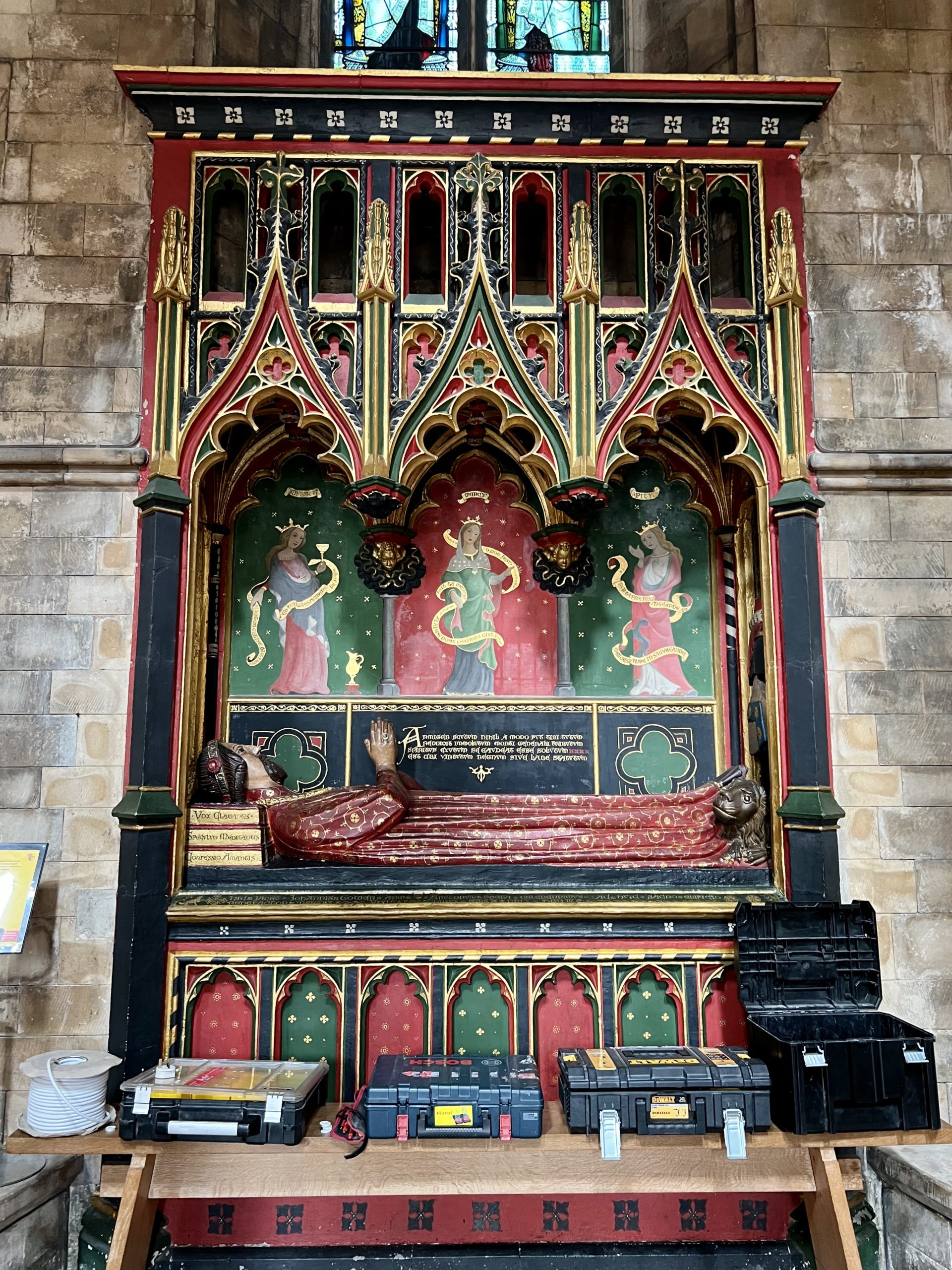
Funerary Tombs
Quite a few former celebrities are buried in Southwark.
John Gower’s medieval tomb in the north aisle is technicolor bright and you can’t miss it. The tomb has a life size effigy of the man known as England’s “first poet.”
Gower was the poet laureate for both Richard II and Henry III. His head lies on three of his allegorical poems written in English, Latin, and French: Mirour de l’Omme (French), Vox Clamantis (Latin), and Confessio Amantis (English).
In the 1370s, he moved into cathedral’s priory cloisters and lived there until his death at age 78.
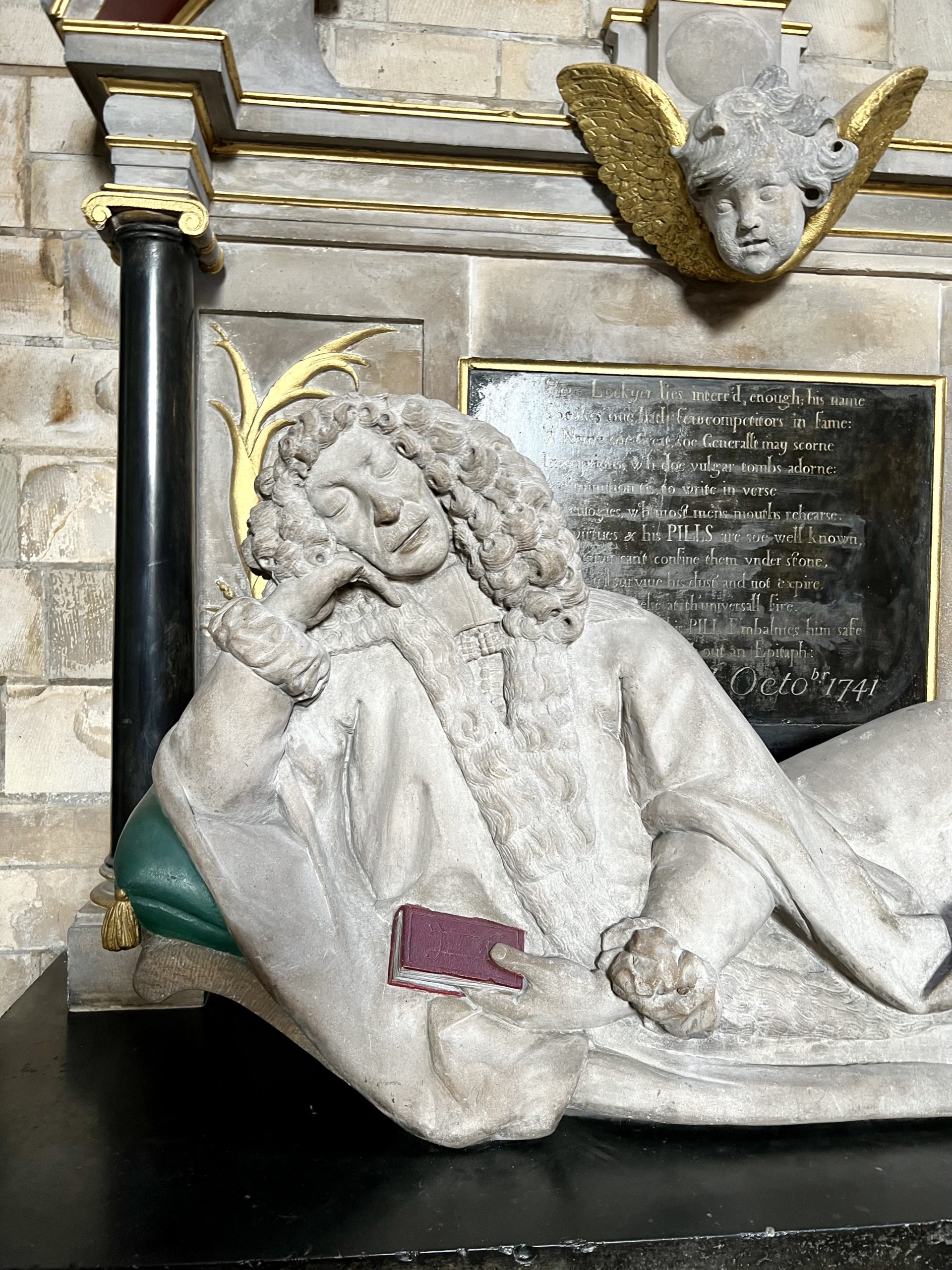
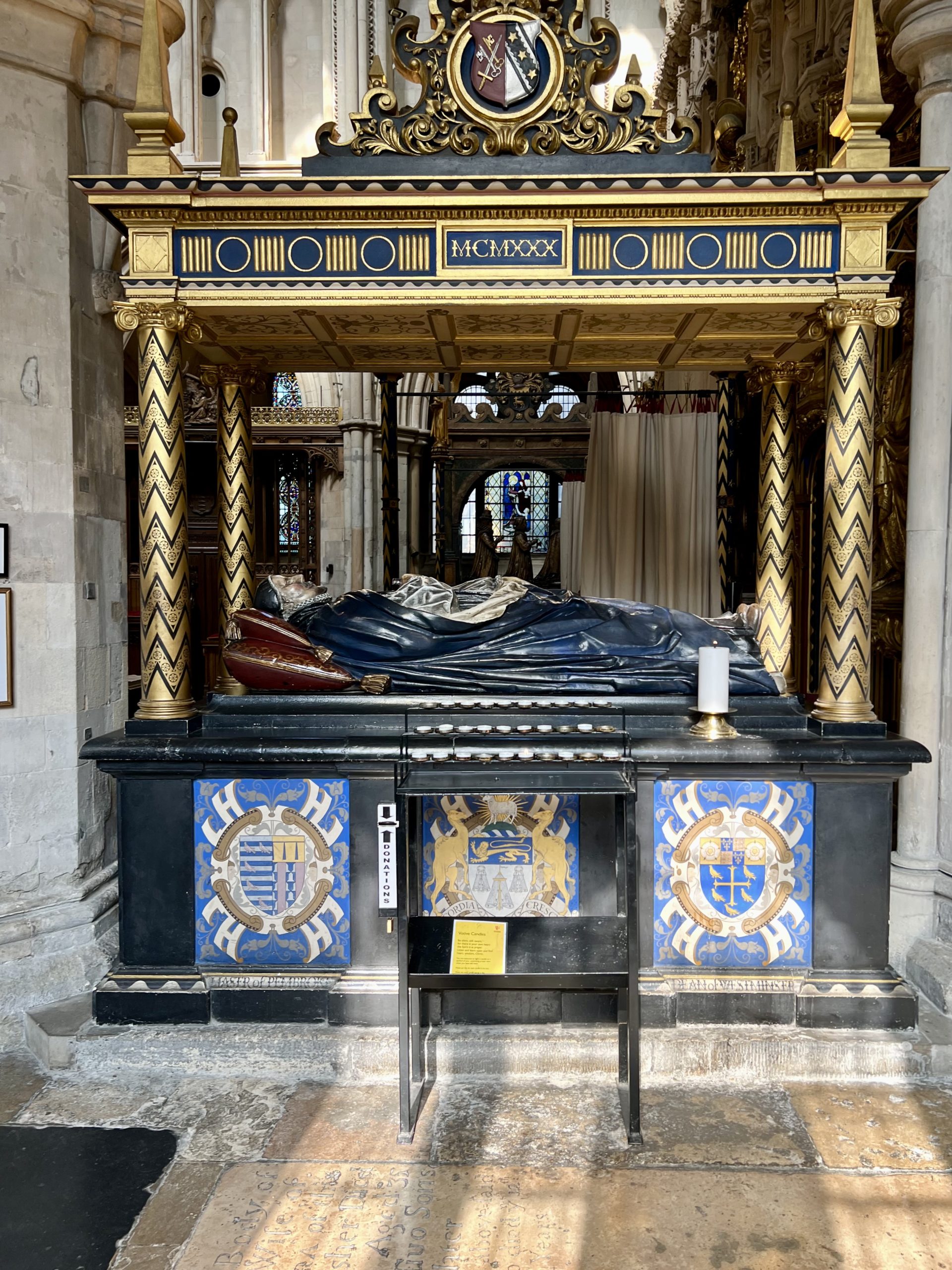
You can also find an anatomical incorrect memorial to Dr. Lockyer. He was a 17th century doctor of dubious reputation who was famous for dispensing magic pills extracted from the sun. His tomb has an amusing inscription about them.
The blue and gold tomb of Bishop Lancelot Andrewes, to the left of the high altar, is also notable. Andrewes was a high ranking bishop and noted church scholar during the reigns of Queen Elizabeth I and James I.
He translated the Old Testament of the King James Bible, assisted at King James’ coronation, and wrote a famous sermon after the Gunpowder Plot. He later became Bishop of Winchester.
Andrewes’ effigy is original and he wears the mantle of the Order of the garter.
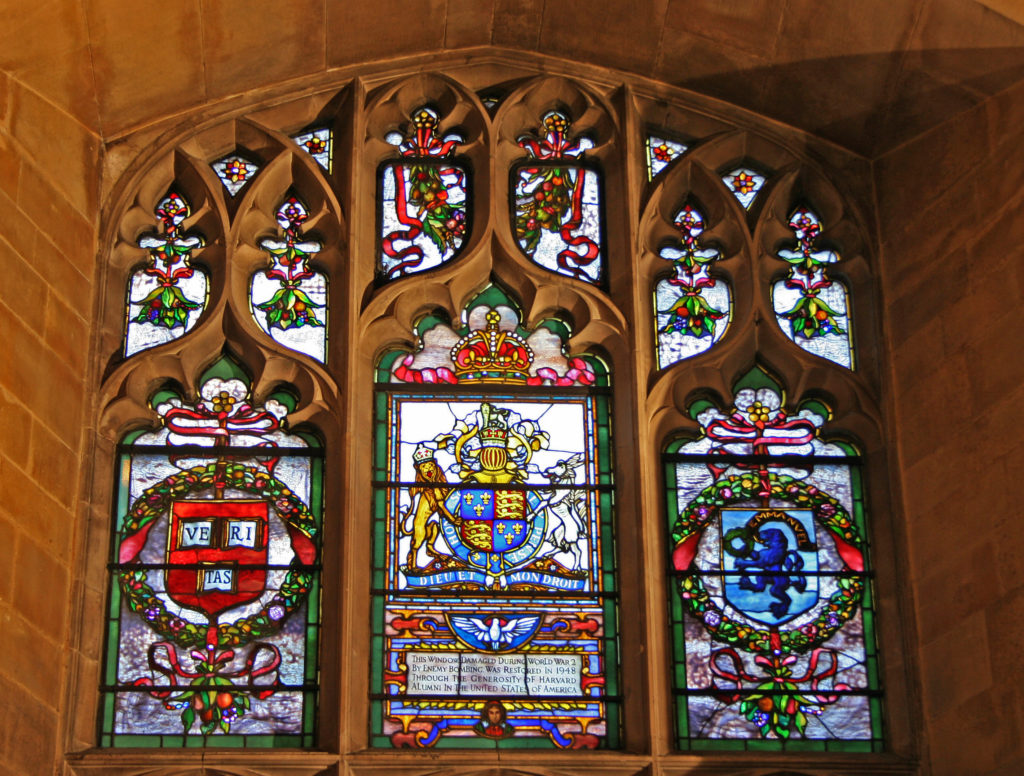
The Harvard Chapel
American visitors, especially Bostonians, should stop and admire the Harvard Chapel. John Harvard was the founder of the Ivy League school Harvard College in Cambridge Massachusetts.
He was baptized in Southwark in 1607. Harvard’s grandfather, Thomas Rogers, knew William Shakespeare’s father. Harvard was born and raised in Southwark before marrying and moving to New England.
The chapel contains some original masonry from the 15th century. American artist John LaFarge created the chapel window. La Farge is widely regarded as the inventor of opalescent glass for church windows, and his techniques make the window very distinctive.
At the top are the coat of arms of Harvard University and the royal coat of arms from the time period. At the bottom, the main subject is the Baptism of Christ, alluding to the original dedication to St. John the Baptist and also to the baptism of Harvard.
The window was damaged in WWII, but restored with donations from Harvard alumni.
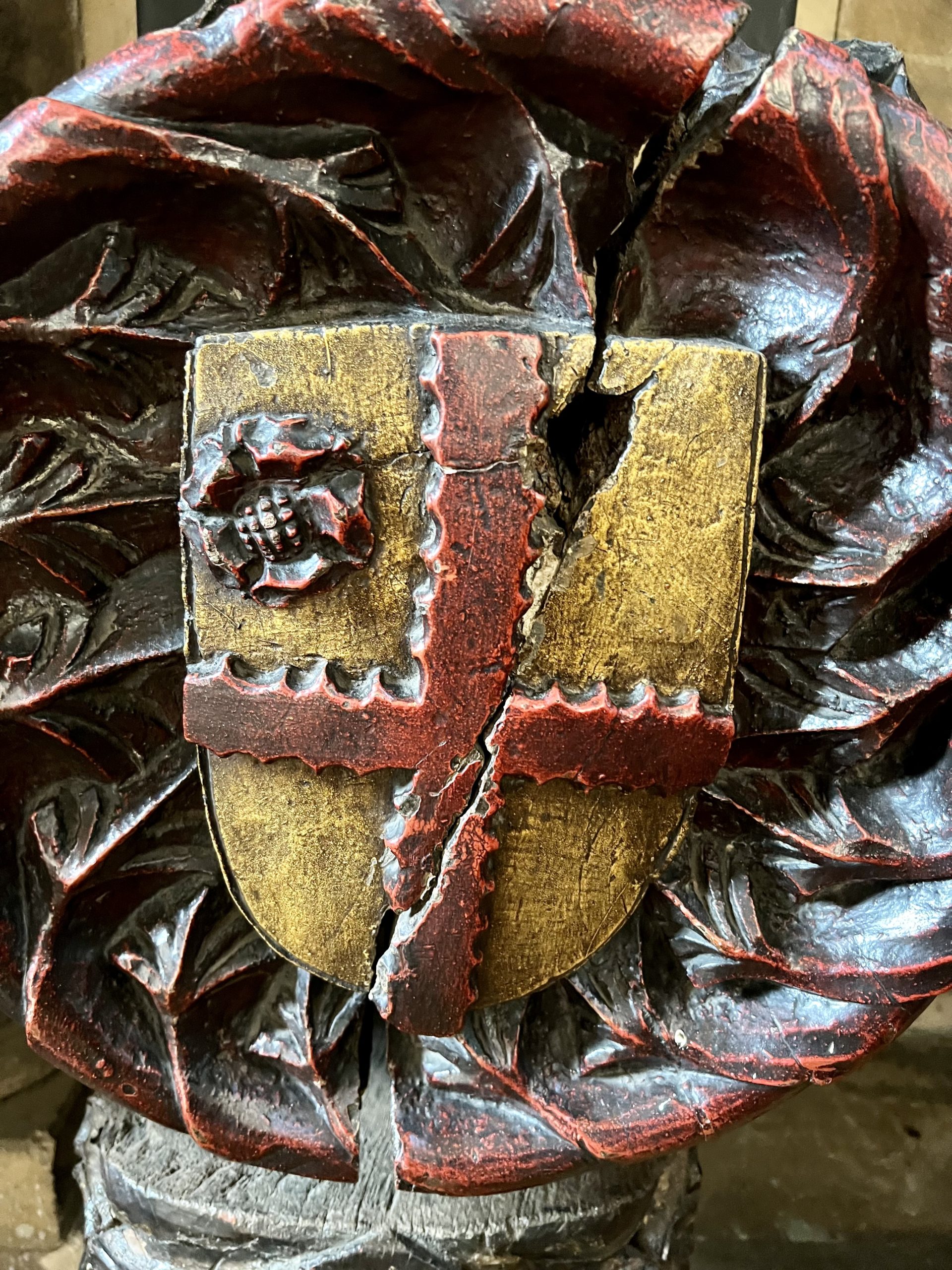
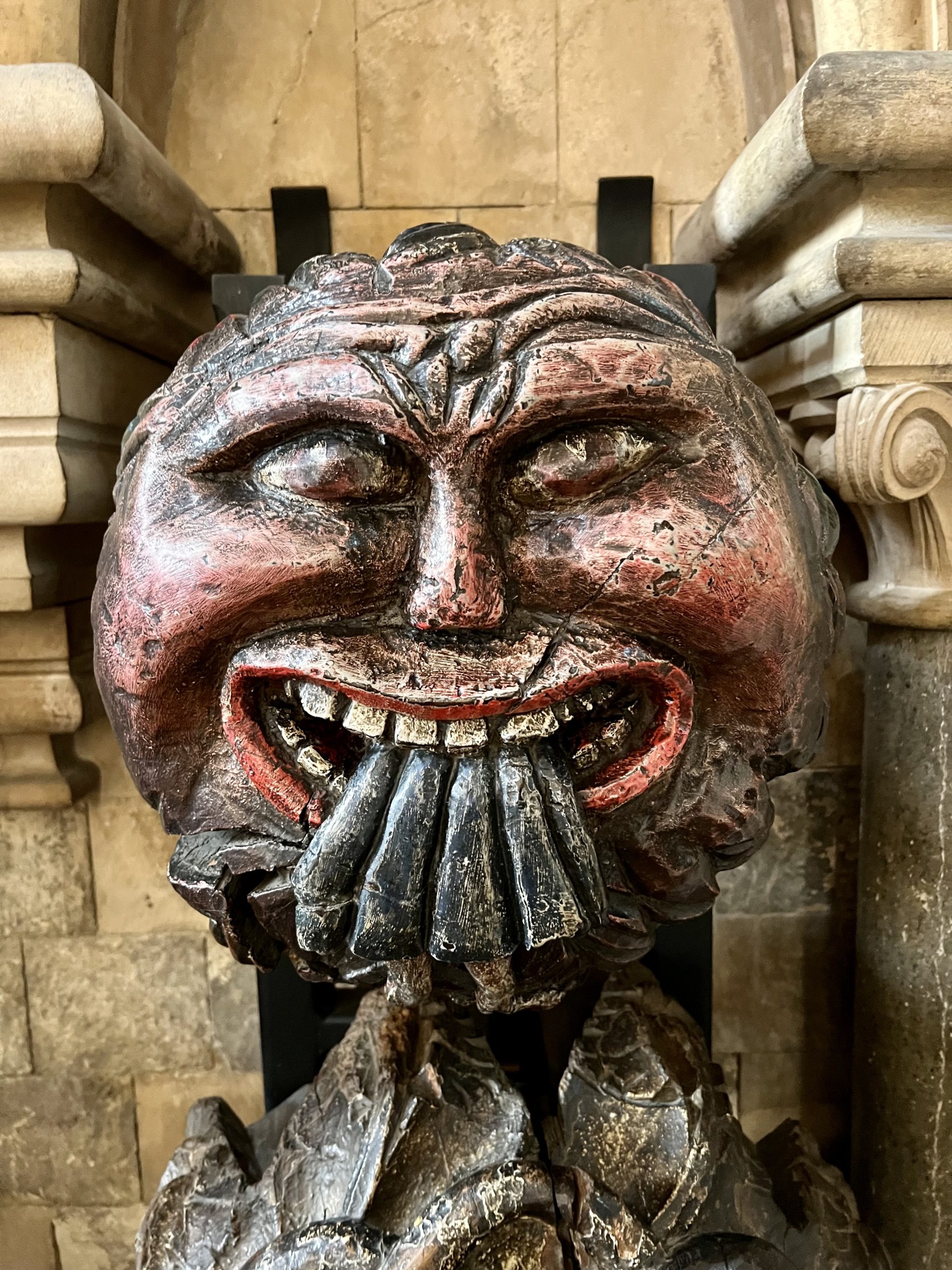
Medieval Carved Roof Bosses
Along the west wall near the baptismal font are some quirky examples of 15th century carved roof bosses from the old nave. A boss is an ornately carved “knot” or “bump” placed where the beams or vaults in a ceiling meet.
Some have been put back into the Tower Crossing. But others are on display and you can get a close up look.
They are about one foot square and carved with gargoyle-like faces, floral designs, and heraldic emblems. You’ll see one of the devil swallowing Judas.
Medieval Effigy Of A Knight
Southwark is also home to a wooden effigy of an unknown knight in the north aisle. Carved between 1280 and 1330, it’s thought to be one of the earliest examples of a wooden effigy in Britain. It’s officially listed as “anonymous,” but some think he was a member of the de Warrene family.
The knight has his legs crossed. This was once thought to indicate the knight was a crusader. Today’s historians believe that the cross legged pose was simply fashionable during the 13th and 14th centuries for military men.
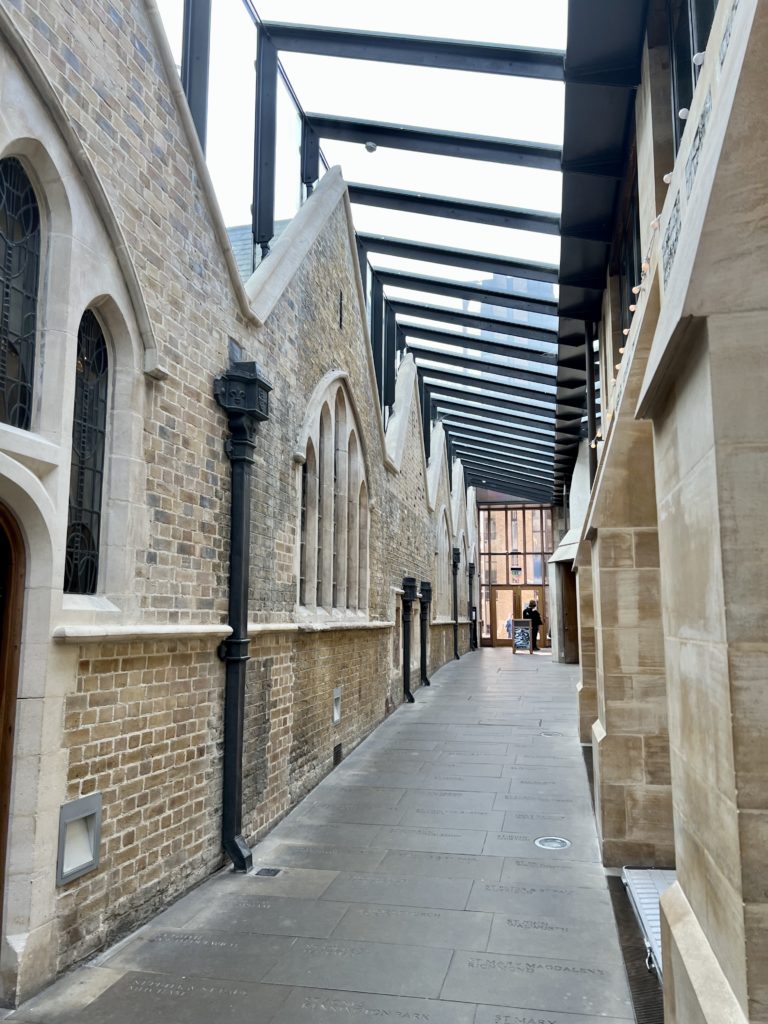
Archaeological Chamber
Excavations in 1999 revealed Southwark’s ancient origins. In 2001, Southwark opened an archaeological chamber.
It displays a portion of a Roman road from the 1st century A.D., part of the 12th century foundation of the Norman Priory and Norman apse, and a 17th century Delft brick kiln. The latter is the only surviving kiln in northern Europe.
Churchyard And Herb Garden
The Churchyard was restored in 2015 and planted with flowers and herbs with biblical and Shakespearean connections. The small herb garden is a historically accurate and contains 50 different plants once used by a medieval apothecary.
There’s also a life size bronze statue of Shakespeare. You can sit down and commune with the Bard.
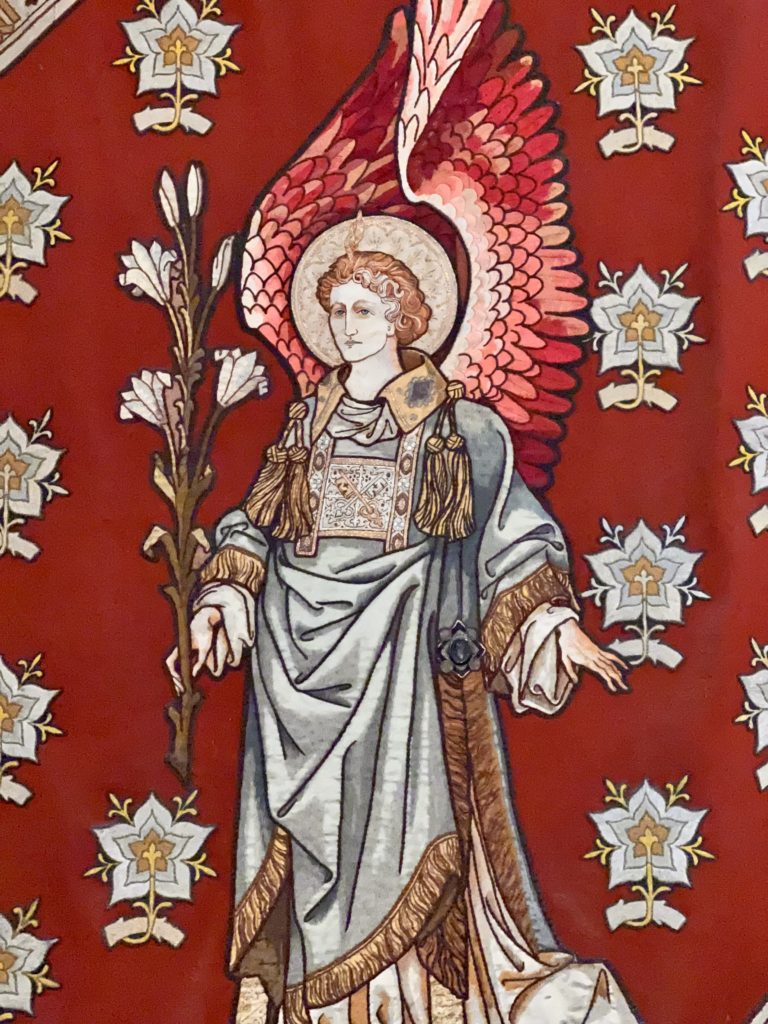
Practical Information For Visiting Southwark Cathedral
Address: London Bridge, London SE1 9DA, United Kingdom. It’s a 10 minute walk from the Tate Modern.
Tube Station: London Bridge
Hours: Monday – Saturday 9:00 am to 6:00 pm, Sunday 8:30 am to 5:00 pm. If you would like to attend a service, click here for a schedule.
Tickets & Tours: Entry to Southwark is free. You can also visit the cathedral on a guided walking tour of the South Bank. The cathedral itself also gives one hour tours. Click here to book one.
Pro Tips: The cathedral is used as a venue for numerous concerts and other events throughout the year. You can check the website to see if anything’s on.
Is Southwark Cathedral Worth Visiting?
I think Southwark Cathedral is well worth visiting, especially if you love all things Gothic and Medieval.
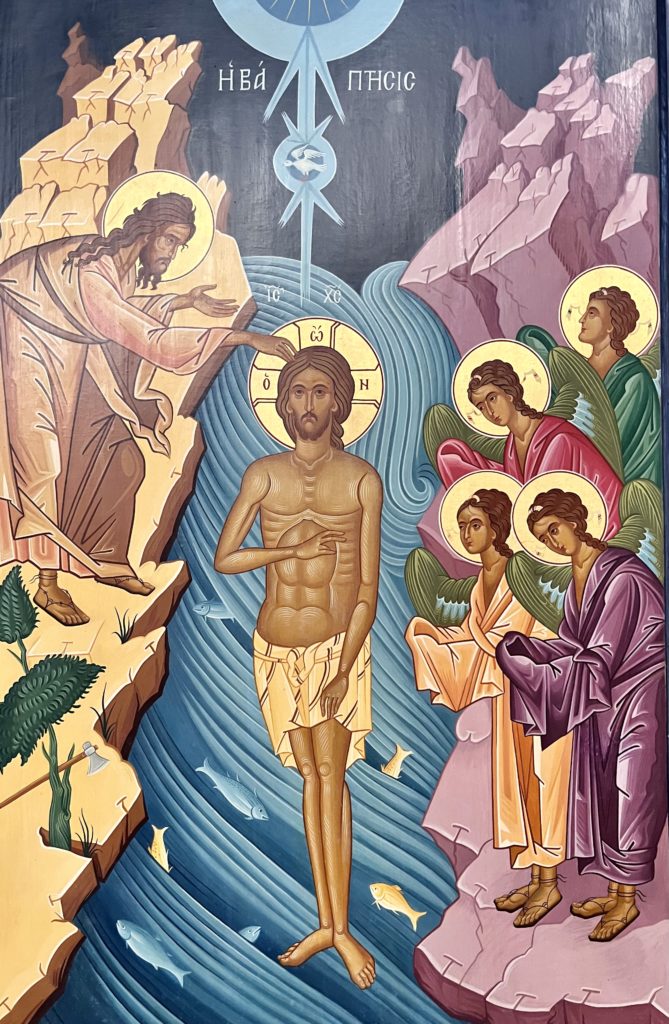
It’s a charming church with scads of jewel-like stained glass and a wealth of monuments. It boasts a storied history that includes famous bishops, royalty, merchants, and even Shakespeare.
Time Required: You can have a quick and fun visit in an hour, more if you want to see every nook and cranny.
Food: If you need to grab lunch before or after you visit, Borough Market is just a few minutes away. It’s a must visit, one of London’s best (and most bustling) markets.
I hope you’ve enjoyed my guide to Southwark Cathedral in London. You may enjoy these other England travel guides and resources:
- 3 Day Itinerary for London
- 5 Day Itinerary for London
- Hidden Gems in London
- 30 Day Trips from London
- Tips For Visiting London
- Best Museums in London
- One Day In Canterbury Itinerary
- One Day in Oxford Itinerary
- One Day In Stratford-upon-Avon
- Harry Potter Places in London
- Guide to Westminster Abbey
- Guide to St. Paul’s Cathedral
If you need a guide for Southwark Cathedral, pin it for later.
